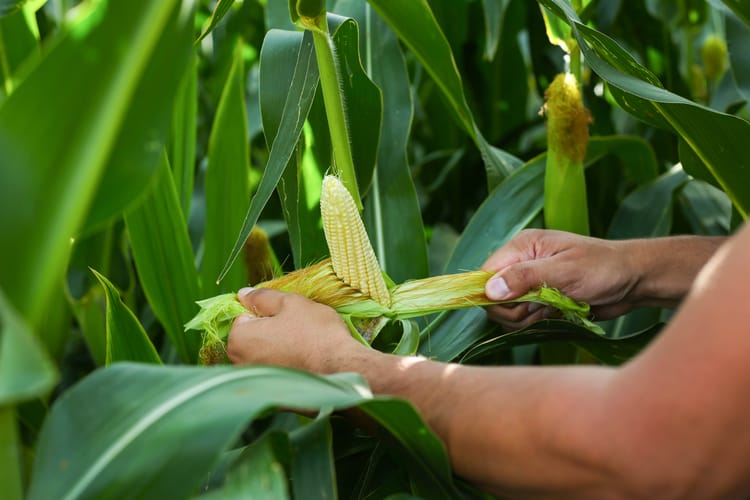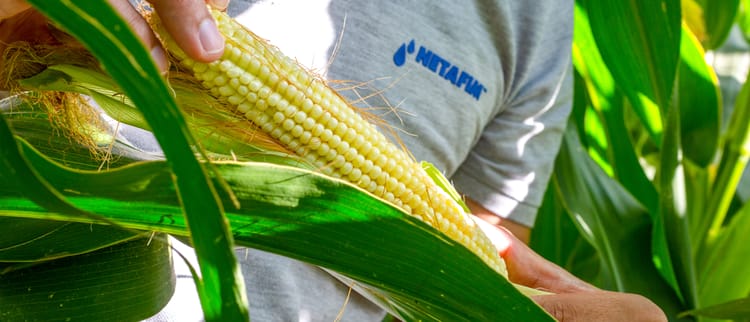Increasing corn yields, while saving water
Growing corn with drip irrigation products has been a common practice in many parts of the world for over 30 years. Drip systems maintain certain unique characteristics that help make them the best irrigation alternative for corn in many growing scenarios.
Drip is ideal for irrigating corn with limited water budgets: Drip increases water use efficiency, since it creates no evaporation or run-off, and the water is precisely targeted to the root zone. Drip fits all plot shapes and sizes: Unlike center pivots and other irrigation methods, drip can be used in odd-shaped and small fields. Drip can achieve perfect water distribution even on extreme slopes: Pressure compensated drippers allow uniform water emission across all parts of the plot regardless of slope, and unlike other irrigation methods, drip installation in sloped areas is common practice. Drip is ideal for rainy areas due to efficient fertilization: Drip enables daily fertilizer application so that the fertilizer can be divided into small portions, leading to less nutrient loss due to leaching caused by rain. Drip requires the lowest energy consumption: Drip operates at low pressures, so it can significantly cut irrigation costs, compared to other pressurized systems in areas where electricity is expensive. Drip is ideal for irrigating uniformly under windy conditions: Drip is unaffected by wind – unlike overhead irrigation systems.
High yields with limited water
In the evolving history of irrigating corn with drip, the first areas worldwide that adopted the method were arid and semiarid locations where water scarcity is severe, and where rain during the growing season is scarce or non-existent. For example, drip has replaced sprinkler and traveler gun irrigation in the area of Konya in central Turkey, where hundreds of thousands of hectares are irrigated annually. There has been a similar trend in parts of the US, especially in Nebraska, Texas and Kansas. In those areas, the depletion of local aquifers has driven producers to look for irrigation practices enabling them to grow more corn with their limited water budget.

From rain-fed to drip – increasing productivity while reducing risk
Next in line to have interest in irrigation in general and in drip irrigation in particular, are the rain-fed corn producers. Traditionally, they have grown crops according to timely rainfall. Today, however, they understand that to secure high and consistent yields year-on-year, they need to irrigate; otherwise, some years will be good, while others will be a financial disaster. Yields in these areas are being driven to new records, due to not only water aspects, but also nutritional aspects. In rainy areas, the leaching of nutrients and the deficits they create limit high yields. Therefore, the ability to spoon-feed the crop with a drip system at any time and with any amount of nutrients is critical to reach high yields.

Drip irrigated corn in South Africa
Although drip is extremely common in many parts of the world, it is rare, even nonexistent, when it comes to growing corn in South Africa. Netafim, the global leader in drip irrigation for over 50 years, will launch four corn irrigation trial sites in South Africa in the 2016/2017 season. Netafim South Africa, along with local dealers, have chosen the sites, which include locations in the Free State, KwaZulu-Natal, North West and Gauteng. ‘The recent drought has made South African corn producers more conscious about water use efficacy, and we have had dozens of inquiries from all over the country. The sites chosen for the initial demo installations represent different growing scenarios in the South African corn market, aiming to help us adjust practices that are common overseas to our local conditions. ‘We are taking into consideration water quality and available quantity, climate, soil, and most importantly, local farm practices and workforce capabilities. American, Turkish or Italian producers are not similar to our producers, and therefore, we need to ensure that the systems we offer are cost-efficient, reliable and easily operated in our conditions,’ Mr. Chris Malan (chief agronomist: Netafim SA) said.


